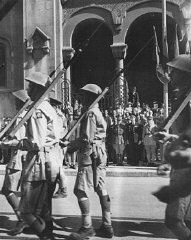You searched for: 柬埔寨youtube开户【TG飞机:@bapingseo】阿塞拜疆谷歌开户优化投放【TG电报:@bapingseo】烏茲別克斯坦短信通道【Telegram:@bapingseo】彩51下载net飞艇计划一期一讲解大小倍投只投4把?aT1031/d8WvRa.html
<< Previous | Displaying results 76-100 of 303 for "柬埔寨youtube开户【TG飞机:@bapingseo】阿塞拜疆谷歌开户优化投放【TG电报:@bapingseo】烏茲別克斯坦短信通道【Telegram:@bapingseo】彩51下载net飞艇计划一期一讲解大小倍投只投4把?aT1031/d8WvRa.html" | Next >>
-
Fürstengrube
ArticleLearn about Fürstengrube subcamp of Auschwitz, including its establishment, administration, prisoner population, and forced labor and conditions in the camp.
-
SS and the Holocaust
ArticleLearn more about the SS and the organization’s involvement in perpetrating the Holocaust.
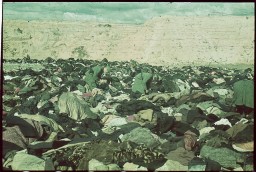
-
Anne Frank: Diary
ArticleThe Diary of Anne Frank is often the first exposure readers have to the history of the Holocaust. Learn about Anne's diary, including excerpts and images.

-
Blechhammer
ArticleThe Germans established the Blechhammer camp as a subcamp of Auschwitz in April 1941. Learn about the camp's history and conditions there.
-
Ruth Meyerowitz describes sabotage effort in Malchow munitions factory
Oral HistoryIn Frankfurt, Ruth's family faced intensifying anti-Jewish measures; her father's business was taken over and Ruth's Jewish school was closed. In April 1943, Ruth and her family were deported to Auschwitz. Ruth was selected for forced labor and assigned to work on road repairs. She also worked in the "Kanada" unit, sorting possessions brought into the camp. In November 1944, Ruth was transferred to the Ravensbrueck camp system, in Germany. She was liberated in May 1945, during a death march from the…

-
Reichstag Fire Decree
ArticleThe Reichstag Fire Decree of February 1933 restricted individual freedoms, and allowed Hitler's government to overrule state and local laws and overthrow state and local governments.

-
Nuremberg Trials
ArticleTrials of top surviving German leaders for Nazi Germany’s crimes began in Nuremberg after World War II. Read about the Nuremberg trials.
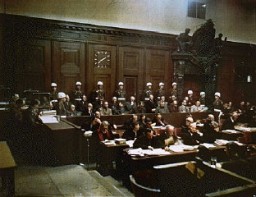
-
Rescue and Resistance
ArticleWhile some European Jews survived the Holocaust by hiding or escaping, others were rescued by non-Jews. Learn more about these acts of resistance.

-
1939: Key Dates
ArticleExplore a timeline of key events during 1939 in the history of Nazi Germany, World War II, and the Holocaust.
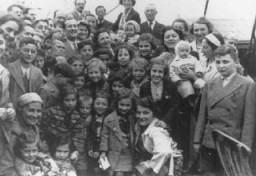
-
1945: Key Dates
ArticleExplore a timeline of key events during 1945 in the history of Nazi Germany, World War II, the Holocaust, and liberation and the aftermath of the Holocaust.

-
Reich Security Main Office (RSHA)
ArticleThe Reich Security Main Office (RSHA), created by Heinrich Himmler, brutally coordinated and perpetrated many aspects of the Holocaust.

-
Mein Kampf
ArticleAdolf Hitler's Mein Kampf (My Struggle) is the best known and most popular Nazi text ever published with over 12 million copies sold from 1925 to 1945.
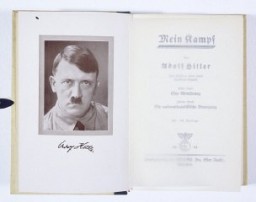
-
Mechelen - Maps
Media EssayIn the summer of 1942, the Germans made preparations to deport the Jews of Belgium. They converted military barracks in the city of Mechelen into a transit camp. Between August 4, 1942, and July 31, 1944, a total of 28 trains carrying 25,257 Jews left Mechelen for German-occupied Poland; most of them went to Auschwitz-Birkenau. This figure represented more than half of the Belgian Jews murdered during the Holocaust.
-
Destruction of Lidice
FilmCzech resistance fighters attacked Reinhard Heydrich, acting governor of the Protectorate of Bohemia and Moravia, in an ambush near Prague in May 1942. Heydrich died of his wounds on June 4, 1942. In retaliation for the attack, the Germans destroyed the village of Lidice on June 10, 1942. The Germans shot all the men in the village and deported most of the women and children to camps in Germany. This footage shows destroyed homes and German officials inspecting the remains of the village.
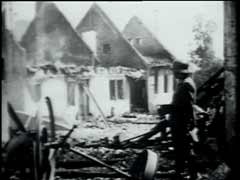
-
Portrait of David Pesso
PhotoPortrait of David Pesso. He was a dealer of second-hand items. He lived at Novatska 4 in Bitola. This photograph was one of the individual and family portraits of members of the Jewish community of Bitola, Macedonia, used by Bulgarian occupation authorities to register the Jewish population prior to its deportation in March 1943.
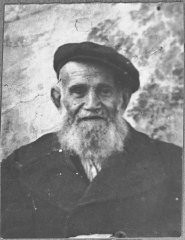
-
A Polish former inmate of Auschwitz testifies during the Pohl/WVHA trial
PhotoA Polish former inmate of Auschwitz identifies Oswald Pohl while on the stand for the prosecution during the Pohl/WVHA trial. This trial, case #4 of the Subsequent Nuremberg Proceedings, took place in a room in the Palace of Justice which was not the main courtroom. Nuremberg, Germany, April 18, 1947.
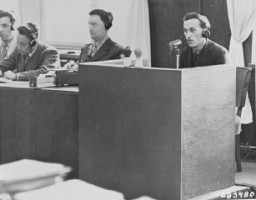
-
Arriving at the Fort Ontario refugee shelter
PhotoJewish refugees from Europe arrive at the emergency refugee shelter at Fort Ontario, in the United States. A father, holding his daughter, checks his tags. Oswego, New York, United States, August 4, 1944.

-
Police search a messenger for a Social Democratic newspaper
PhotoPolice search a messenger at the entrance to the building where Vorwaerts, a Social-Democratic Party newspaper, was published. The building was subsequently occupied during the suppression of the political left wing in Germany that was carried out in response to the Reichstag Fire. Berlin, Germany, March 3–4, 1933.
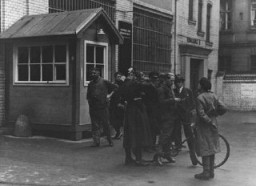
-
US soldiers view the charred remains of prisoners at Ohrdruf
PhotoWhile on an inspection tour of the newly liberated Ohrdruf concentration camp, American soldiers view the charred remains of prisoners burned upon a section of railroad track during the evacuation of the camp. Ohrdruf, Germany, April 4-15, 1945.
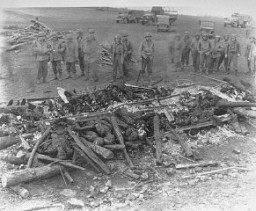
-
The main gate of the Wöbbelin concentration camp
PhotoThe main gate of the Wöbbelin concentration camp. On May 2, 1945, the 8th Infantry Division and the 82nd Airborne Division encountered the Wöbbelin concentration camp. Photograph taken upon the liberation of the camp by US forces. Germany, May 4, 1945.

-
Antisemitic sign outside a town in northern Bavaria
PhotoA sign outside a town in northern Bavaria warns: "City of Hersbruck. This lovely city of Hersbruck, this glorious spot of earth, was created only for Germans and not for Jews. Jews are therefore not welcome." Hersbruck, Germany, May 4, 1935.
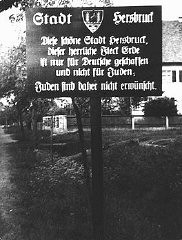
-
Martin Niemöller on a visit to the United States after World War II
PhotoMartin Niemöller, a German theologian and pastor, on a visit to the United States after the war. A leader of the anti-Nazi Confessing Church, he spent the last seven years of Nazi rule in concentration camps. United States, October 4, 1946.
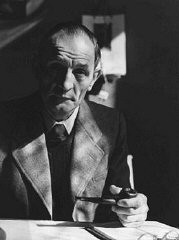
-
Aerial photograph of Auschwitz-Birkenau
PhotoAerial photograph of Auschwitz II (Birkenau). Poland, December 21, 1944. This image is one of a series of aerial photographs taken by Allied reconnaissance units under the command of the 15th US Army Air Force during missions dating between April 4, 1944, and January 14, 1945.

-
Page from Otto Wolf's diary
PhotoOtto Wolf (1927-1945) was a Czech Jewish teenager who chronicled his family's experience living in hiding in rural Moravia during World War II. His diary was published posthumously. This image shows book 4 of Otto Wolf's diary. This is the first entry by Felicitas Garda (Otto Wolf's sister) dated April 17, 1945. Felicitas continued Otto's diary after his disappearance.
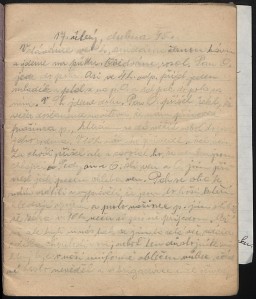
-
Tunisia Campaign
ArticleLearn more about the 1943 Tunisia campaign, a four-month long struggle between Allied and Axis powers in North Africa during World War II.
